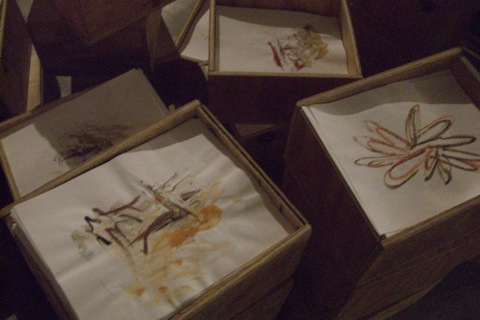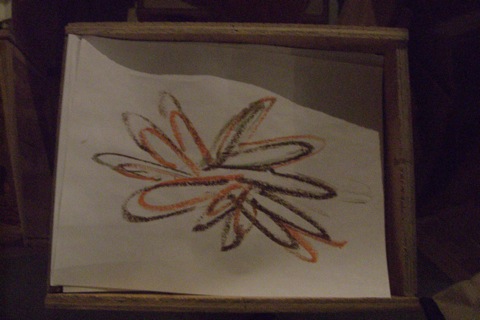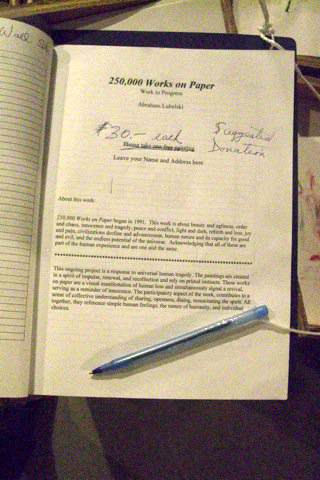[Originally published on Huffington Post HERE.]
BY CATHERINE SPAETH
On Saturday night I attended the exhibit No Comment, held in what used to be the offices of JP Morgan, located on Wall Street. For blocks around, the police had barricaded the sidewalks, and so getting there was a roundabout effort. Perhaps for this reason there was not a crowd, maybe only a few more than a dozen hanging around outside the door; one of which was a woman having her body painted from head to toe -- inside I later saw her posing her body on a sphere, not far from a fellow making giant soap bubbles.
My self-assigned job was to take a picture of one thing interesting. There were only these few hours, and I assumed the artists would likely be people that I had never heard of, or at least not recognizable to me, and that if I took a picture it would at least be a place to begin. Perhaps I was drawn to the discursive commentary that on the face of it this work provides, I'm not sure, but in what follows below are the photos that I took, in order, of a single work.
 Abraham Lubelski, 250,000 works on paper, 1991-present
Abraham Lubelski, 250,000 works on paper, 1991-present
It was not until I got home and did some research that I had any idea at all who the artist was. I discovered that in the late '60s Abraham Lubelski exhibited at the now closed Chelsea National Bank a piece called Paper Money Made Into Art You Can Bank On.
This was $250,000.00 in bills tied up in bales and displayed in the bank itself, on exhibit for five days and costing the artist $300.00 in interest. It is difficult to imagine the effect of this piece, exhibited in the bank and visible only to those who are banking. An amused and coveting desire? Fear for one's safety?
More legible might be that the installation of 250,000 drawings pictured here was also in the previous exhibit in the JP Morgan building, XI/II: A Tribute to 9/11. In that context -- the same space, same installation, just prior to No Comment -- the drawings were being offered for free. And so there is an economy of the gift, drawing on the by now well worn motif of papers drifting down the streets of New York. Themed on 9/11 the original exhibit was intended for those who work in the financial district of New York -- that would be the top one percent. For a long time now much of the artworld has been pitching its wares to, if not actively run by, the "non-profiteering" pump and dump collectors who are the one percent. Because of its location, this exhibit was one of them.

A significant difference between the previous installation and the current one, however, is that in No Comment there is a suggested donation of $30 for each drawing. Granted, the first exhibit lost some money because of the demonstrations, and has since tried to collaborate with artists of Occupy Wall Street in order to recover their losses and to provide a space for activist artists to show their work, and studio space to make it. I don't close out the thought that this can be a beneficial relationship, but it should not be an uncritical one. For example, in a public forum about the upcoming exhibit "Aristedes" writes of the No Comment auction as "A Landmark, Historic, most important ART AUCTION of the year!... This show will be remembered for years into the future & can only grow in stature!." But the auction is where the power of the one per centers lies -- a price at auction is now all it takes to count as art history in that art world.

With regard to 250,000 Drawings, two different things occur that strongly effect the speculative value of art: first, there is an easy art historical narrative ready to hand, and second, there is in this as well an appreciation of the hand made, and of free-hand drawing in particular as an expressive freedom. These appeal to both the discursive side and that of the immersive direct experience, and that there is excessive and measurable labor involved (250,000) underscores the surplus value of both. In On (Surplus) Value in Art Diedrich Diederichsen explains that these two sides are dependent on one another in the current art market. The art world has come to depend on anecdotes and punch lines in its discourse, a discourse that keeps things moving, however more sales will occur of works that require no justification. He writes:
Of course, all of the works of this type -- the ones that require no justification -- are actually indirectly justified by other art works. They are, as it were, instances of a legitimation that has congealed and become unobtrusive. They are able to forego justifications and give off the heavy scent of immanence, in which the business of art is so fond of steeping... It is works of this kind that finance the everyday operations of the art industry. They circulate throughout the world, and images of them fill the catalogues and art magazines. Yet it is only works of the first type - those that are openly in need of legitimation -- that keep the discourse alive.*

Given this dependence of objects that ask for no justification upon the discursive works that keep things mobilizing, most interesting of all is that Abraham Lubelski is the owner of a number of arts enterprises, among them NY Arts Magazine and the Broadway Gallery, a magazine and a gallery enterprise where writers are unpaid and artists are aggressively solicited to pay to play. Vanity galleries are less known for sales and cultivating a reputation than for the amount of artists swinging through the doors, that is where the money is for them. There are many discontented artists describing these practices on websites. More favorable and by one of his own past writers, Charles Giuliano writes that upon inviting Lubelski to the New England School of Art and Design at Suffolk University to exhibit, Lubelski was not forthcoming as to what this might be and only shortly beforehand gave him the title, The Show Has Been Cancelled, for a piece in which the artist sat on a sofa and chatted people up. Writes Giuliano:
So I view him as the Pied Piper of the art world. Luring us out of the city while dancing to his merry tune. Leading us on to what and where? It is about desperation, the need to be loved and accepted. To get published, seen, endorsed and recognized. Abraham is a conveyor of hope for many. With him anything is possible. He says, "I keep trying, putting ideas out there, engaging in dialogue."
And so we have some pictures of a single work, and some information surrounding it. I know very little and yet what investigating this one object suggests to me is that how artists participate in institutional spaces -- as artists -- and who they share it with might be more important than the artists of Occupy Wall Street seem at this point -- in inclusiveness, the defense of free speech, and desire for visibility -- ready to make any strong decisions about. Coverage such as the recent New York Times post is valuable for drawing attention to the spatial detournement of occupying J.P Morgan, but it seems to me that there is more at stake than symbolic space. Abraham Lubelski has now begun an fundraising exhibit to raise funds for Occupy Wall Street, at his Broadway Gallery. More and more "artist activist entrepreneurs" are arriving on the scene, here for example is a link to Revolution Art Magazine, complete with pinups and product. The question of art and money as it relates to Wall Street has been haunting the art world for some time now -- what "alternatives" are you willing to settle for?
* Diedrich Diederichsen, On (Surplus) Value in Art, Reflections 01, Sternberg Press and Witte de With Publishers, 2011, p. 29.
 Sunday, January 15, 2012 at 07:29AM
Sunday, January 15, 2012 at 07:29AM  admin |
admin |  Post a Comment |
Post a Comment |  press,
press,  wish tree,
wish tree,  yoko ono,
yoko ono,  zuccotti park in
zuccotti park in  celebration,
celebration,  participation,
participation,  performance,
performance,  press
press 
 Abraham Lubelski, 250,000 works on paper, 1991-present
Abraham Lubelski, 250,000 works on paper, 1991-present

